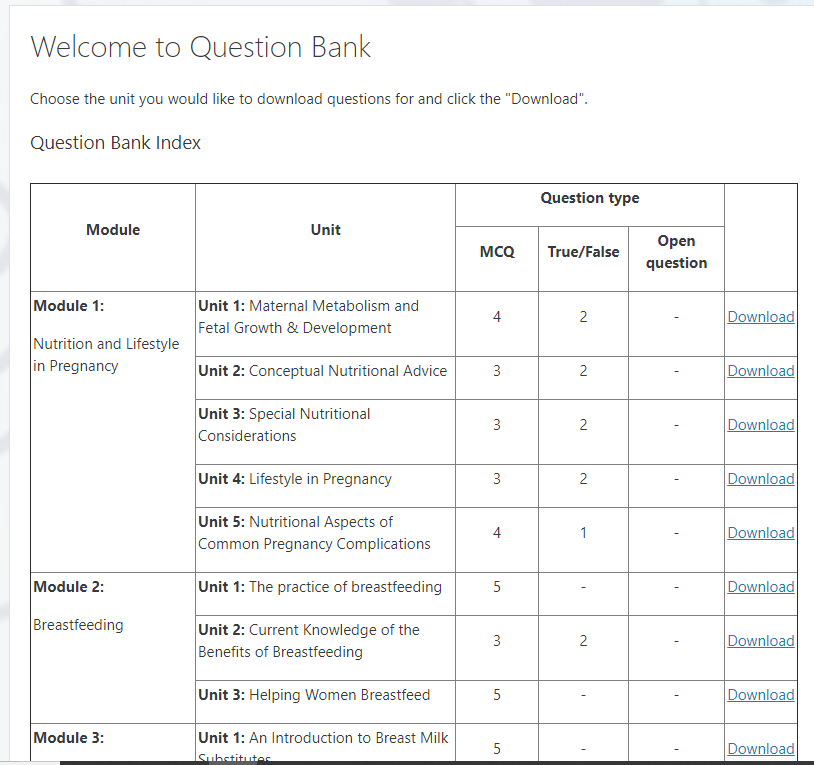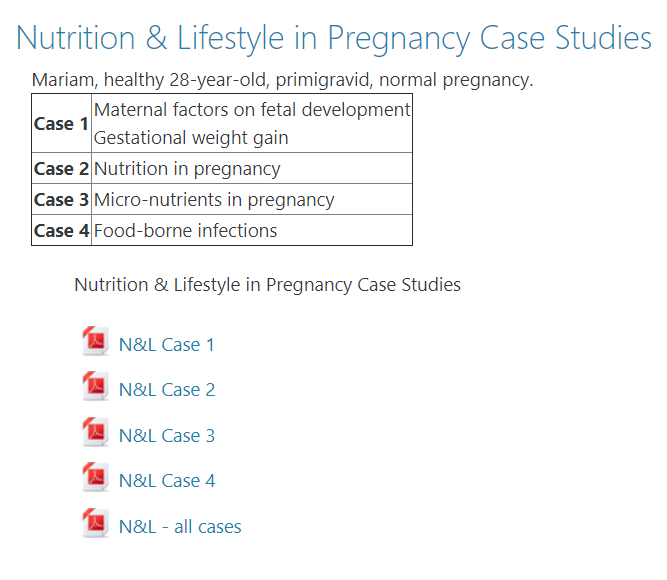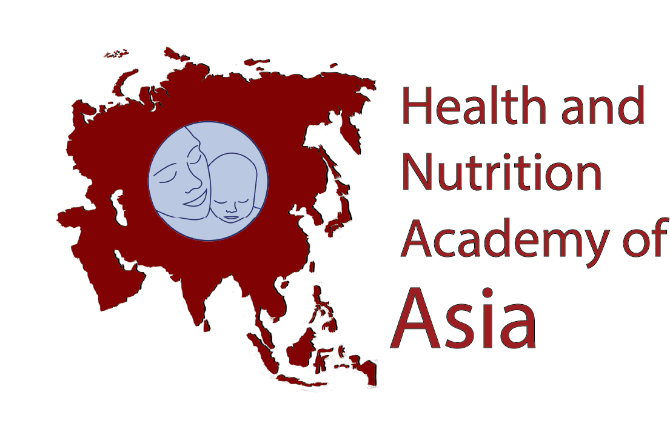In addition to the ENeA SEA eLearning modules, we have developed question bank, case studies and easy to use e-learning tools for tutors/educators. If you are a tutor/educator, please continue to read this section so that you can find out what they are and how you can use them.
With these resources we aim to support you to devise and implement an effective teaching and learning strategy appropriate for your context. Our expected outcomes include active learner centred learning through blended teaching and learning and enhanced student learning experience in early nutrition. We also anticipate these will help you increase the topics you teach in the same teaching time and/or reduce teaching time for the same number of topics that are currently taught face-to-face only.
1)
Question bank
We have prepared a set of questions, consisting of multiple choice, true/false and open questions, for each module unit. We packaged the questions per unit separately in a Word document so that you can download what you need. Each question has the correct answer, explanation and information about related lesson(s). Figure 1 shows the image of the question bank page.

Figure 1: Question bank page
The question bank requires login and password, and its access is strictly limited to tutors/educators only. You can download and use these questions in a face-to-face teaching before or after students take related SEA module(s). You can use the questions either as part of your teaching session or as a formative assessment.
If you are using PowerPoint and prefer a low technology solution, you can incorporate the questions to your PowerPoint slides and ask your students to answer each question – either independently or as a group. If you are familiar with quiz tools or are keen to try our recommended easy-to-use eLearning tools, implement the questions in your chosen interactive quiz tool.
If you choose to implement the downloaded questions as an interactive quiz using a freely available quiz tool such as Kahoot, please consider sharing the quiz with other tutors/educators. Visit the e-learning tools section to find out freely available, easy-to-use tools. We shared a small sample of useful web 2.0 tools such as Socrative and Kahoot, as well as Google Forms and Microsoft Forms for polling and surveys.
2) Case studies
Scenario-based case studies are available for 4 ENeA SEA modules: nutrition and lifestyle in pregnancy, breastfeeding, breastmilk substitute and nutritional care of preterm infants. The complementary feeding and management of malnutrition modules have been developed as being scenario-based, and you can choose case scenarios that you would like to use in your teaching from the modules.
Each module has a case scenario and a case has multiple scenes. The same characters in one case may appear in other module case scenarios; for example, Mariam in the pregnancy module appears in the breastfeeding module with her son, Chris.
Each scene has questions that could be posed together with the case scenario and related unit/lesson and key topics, as shown in Figure 2.

Figure 2: Case study scenario page
There are various ways you can utilise the case scenarios, such as face-to-face case-based teaching, or self-directed supportive learning for assignment.
For face-to-face case-based teaching, you can ask students to complete the ENeA SEA module/unit relevant to the teaching session prior to the teaching.
Then you can divide students into groups and ask them to come up with group answers for each question and their reasons. Alternatively, you can recommend that students complete the module/unit after your face-to-face case-based teaching and test their knowledge briefly using the module/unit questions available in the Question Bank section.
In addition, you can use a case scenario as a formative assignment before your face-to-face teaching. You can ask students to answer full or part of case scenario questions before the teaching session and they can use related SEA module/units to prepare their answers.
As the case study questions are open-ended, if you are using PowerPoint slides you can embed selected scenarios and questions into these for your teaching session.
3) E-learning tools
We have selected easy-to-use e-learning tools that may be helpful to you. The e-learning tools section introduces Socrative, Kahoot and Google Form and describes what you can use them for. You can use these tools to facilitate interactive learning in a face-to-face teaching session or self-directed learning. First consider what activities you would like to engage your students with and then choose a tool that will enable you to implement and facilitate the activities easily and effectively.
Please let us and other tutors/educators know what you used the tools for and whether they were helpful. And if you know other easy-to-use tools useful for teaching, share the information with us and other tutors/educators. Visit the e-learning tools page and try out the recommended tools.
